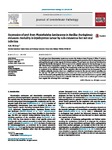Expression of prtA from Photorhabdus luminescens in Bacillus thuringiensis enhances mortality in lepidopteran larvae by sub-cutaneous but not oral infection.
| dc.contributor.author | Bishop, AH | en |
| dc.date.accessioned | 2017-11-17T17:14:02Z | |
| dc.date.available | 2017-11-17T17:14:02Z | |
| dc.date.issued | 2014-09 | en |
| dc.identifier.uri | http://hdl.handle.net/10026.1/10204 | |
| dc.description.abstract |
The prtA gene from Photorhabdus luminescens encodes the virulence factor Protease A. When P. luminescens is injected into the hemocoel of insects by entomopathogenic nematodes, PrtA is a key component of pathogenicity thought to help degrade the immune system. The prtA gene was cloned and introduced on a plasmid into Bacillus thuringiensis. PrtA was shown to be actively expressed in vitro by cleavage of a specific Dabcyl-Edans heptapeptide substrate. There was no difference in the speed or level of mortality when spores and δ-endotoxins crystals of the transformed strain were fed to larvae of Pieris brassicae, as compared to the wild-type strain. When vegetative cells were injected into the hemocoel of larvae of Galleriamellonella, however, there was a significant increase in the rate and level of mortality over the wild type. The yield of B. thuringiensis per cadaver was a hundred-fold greater in the PrtA-secreting strain. The increased pathogenicity from intrahemocoelic infection may have been due to a greater ability to overcome the immune response of G. mellonella while other factors such as resident gut bacteria may have negated this advantage after oral dosage. | en |
| dc.format.extent | 85 - 88 | en |
| dc.language | eng | en |
| dc.language.iso | eng | en |
| dc.subject | Bacillus thuringiensis | en |
| dc.subject | Lepidoptera | en |
| dc.subject | Pathogenicity | en |
| dc.subject | Photorhabdus luminescens | en |
| dc.subject | prtA Expression | en |
| dc.subject | Animals | en |
| dc.subject | Bacillus thuringiensis | en |
| dc.subject | Cloning, Molecular | en |
| dc.subject | Metalloendopeptidases | en |
| dc.subject | Moths | en |
| dc.subject | Organisms, Genetically Modified | en |
| dc.subject | Pest Control, Biological | en |
| dc.subject | Virulence Factors | en |
| dc.title | Expression of prtA from Photorhabdus luminescens in Bacillus thuringiensis enhances mortality in lepidopteran larvae by sub-cutaneous but not oral infection. | en |
| dc.type | Journal Article | |
| plymouth.author-url | https://www.ncbi.nlm.nih.gov/pubmed/25036004 | en |
| plymouth.volume | 121 | en |
| plymouth.publication-status | Published | en |
| plymouth.journal | J Invertebr Pathol | en |
| dc.identifier.doi | 10.1016/j.jip.2014.07.001 | en |
| plymouth.organisational-group | /Plymouth | |
| plymouth.organisational-group | /Plymouth/Faculty of Science and Engineering | |
| plymouth.organisational-group | /Plymouth/REF 2021 Researchers by UoA | |
| plymouth.organisational-group | /Plymouth/REF 2021 Researchers by UoA/UoA06 Agriculture, Veterinary and Food Science | |
| dc.publisher.place | United States | en |
| dcterms.dateAccepted | 2014-07-07 | en |
| dc.identifier.eissn | 1096-0805 | en |
| dc.rights.embargoperiod | Not known | en |
| rioxxterms.versionofrecord | 10.1016/j.jip.2014.07.001 | en |
| rioxxterms.licenseref.uri | http://www.rioxx.net/licenses/all-rights-reserved | en |
| rioxxterms.licenseref.startdate | 2014-09 | en |
| rioxxterms.type | Journal Article/Review | en |


